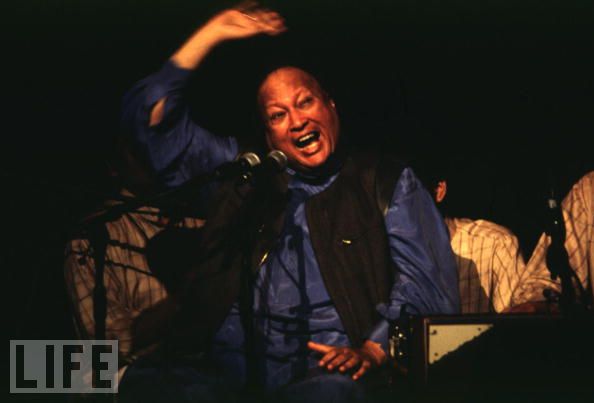Singing in Urdu and his native Punjabi, as well as Persian, and blending traditional stylings with a vast array of outside textures, Nusrat is much credited for the modern evolution of Qawwali. Although not the first to do so, he popularized the blending of khayal singing and techniques with Qawwali; this in short took the form of improvised solos during the songs using the sargam technique, in which the performer sings the names of the notes he is singing.
Despite Nusrat’s unique style, his songs usually did not deviate too far from the art form’s standard template. The normal structure of a Qawwali song begins with a short instrumental prelude played on the harmonium and tabla. Then the instruments stop, and the main singers (but not the chorus) launch into the alap, which establishes the raga, or the tonal structure of the song. At this point, introductory poetic verses are sung. These are usually drawn not from the main song, but from other thematically related songs. The melody is then improvised within the structure of the raga. This improvisation has been explained as the improviser acting as a direct vessel, or channel, of the spiritual realm.
After the introductory verses, the rhythmic portion of the song begins. The tabla and dholak begin to play, and the chorus aids and abets the percussion by clapping their hands. From there, the song proceeds in a call-and-response format. This loose, though structured format explains why the same song may be sung quite differently by different groups though still maintain its basic essence. The lyrics will be essentially the same, but the melody can differ depending on which gharana or lineage the group belongs to. As is the custom in the Qawwali form, Nusrat and the side-singers will interject alapsolos and fragments of other poems or even improvised lyrics. A song usually has two or three sets of refrains, which can be compared to the verse-chorus structure found in western music. Songs last about 20 minutes on average, with some lasting an hour or even more.
Nusrat was noted for introducing other forms of improvisation into the standard style. From his classical music training, he would interject much more complex alap improvisations, with more vibrato and note bending. His interjection of sargam improvisations was also quite unique.
Lets listen to Rahat’s Explanation on NFAK’s Music
“Unhone ek guldasta banaaya,” says Rahat. “Usme qawwali, thumri, ghazal, muktalif kism ki musical forms ko shaamil kiya.” Nusrat made a bouquet of musical styles, but unlike what the purists say, he did not compromise while doing that. “Everthing he did retained the flavour of qawwali,” says Rahat. The essence of his music, in other words, drew from the same spiritual yearning that marks out qawwali music.
One of the biggest gripes around Nusrat – and, indeed, against Rahat today – is that he demeaned qawwali music by taking it out of its original setting of dargahs and suchlike, and into marriage functions and Bollywood. I ask Rahat about that, about how one can reconcile the original intent of qawwali as a spiritual tool with its use today for entertainment.
“You can listen to every qawwali in two ways,” he tells me. “When we sing of ‘sharaab’ and ‘suroor’, you can take the meaning to be either literal, or a metaphor for something spiritual. It depends on the person listening to it, not on the setting.”
In 1985, Nusrat performed at a festival in Cornwall, and that is where the West sat up and took notice of him. As the years went by, collaborations, albums and concerts followed, most notably his remarkable series of albums with Real World.
“Did he adapt his music for Western Audiences?” I ask Rahat. “Was there a difference between the music he performed in Pakistan and that abroad?”
“There had to be,” says Rahat. “The music he performed abroad had much more of classical content. Foreigners didn’t understand our language and our lyrics, so the music had to work harder.”
Also, if I may speculate, foreigners unused to classical music were likely to be far more impressed by meandering alaaps than local audiences, who had seen plenty of that stuff, and whose expectations from the music were often different. In other words, Nusrat perhaps played to his Western audiences a bit, gave them the exotica he craved – but always without compromising the essence of his music.
I ask Rahat about Star Rise
, the Real World compilation of some of Nusrat’s music remixed by stars of the Asian Underground. It’s the only work featuring Nusrat’s voice that I simply can’t stand, and I ask Rahat what Nusrat thought of such remixes. Rahat laughs. “Nusrat hated it,” he says. “He felt they had destroyed his music.”
Source: Amit Verma, India Uncut


Looking for the lyrics of “Kive mukhre to nazra hatawa”.
If they are not published – any worthless punjabi guy can pen it down and do us a favour.
I must have them – can you please oblige – I pledge a 100 bucks for it.
Hey there, do you have Nusrat’s original song named ‘Jab tere dard mein dil dukhta tha”? Cos I’ve been searching it all over the internet and looks like you don’t have it here either. Looking forward to your kind reply, thanks!
is it this one
https://soundcloud.com/hamza-faheem/jab-tere-dard-mein-dil-dukhta
I am also looking for complete original Qwali, Please share!!!! Some one???
Give me full Qawali Gorakh Dhandha..
Please could you translate Oothe Amla te hone ne navede